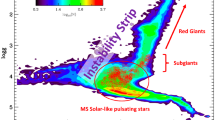Abstract
We created a self-consistent triaxial stellar system through the cold disipationless collapse of 100,000 particles whose evolution was followed with a multipolar code. The resulting system rotates slowly even though its total angular momentum is zero, i.e., it offers an example of figure rotation. The potential of the system was subsequently approximated with interpolating formulae yielding a smooth potential stationary in the rotating frame. The Lyapunov exponents could then be computed for a randomly selected sample of 3,472 of the bodies that make up the system, allowing the recognition of regular and partially and fully chaotic orbits. The regular orbits were Fourier analyzed and classified using their locations on the frequency map. A comparison with a similar non-rotating model showed that the fraction of chaotic orbits is slightly but significantly enhanced in the rotating model; alternatively, there are no significant differences between the corresponding fractions neither of partially and fully chaotic orbits nor of long axis tubes, short axis tubes, boxes and boxlets among the regular orbits. This is a reasonable result because the rotation causes a breaking of the symmetry that may increase chaotic effects, but the rotation velocity is probably too small to produce any other significant differences. The increase in the fraction of chaotic orbits in the rotating system seems to be due mainly to the effect of the Coriolis force, rather than the centrifugal force, in good agreement with the results of other investigations.
Similar content being viewed by others
References
Aarseth S.J. (2003): Gravitational N-body Simulations. Cambridge University Press, Cambridge
Binney J., Spergel D. (1982): Spectral stellar dynamics. Astrophys. J. 252, 308–321
Binney J., Spergel D. (1984): Spectral stellar dynamics. II—the action integrals. MNRAS, 206, 159–177
Binney J., Tremaine S. (1987): Galactic Dynamics. Princeton University Press, Princenton, NJ
Carpintero D.D., Aguilar L.A. (1998): Orbit classification in arbitrary 2D and 3D potentials. MNRAS, 298(1): 1–21
Carpintero D.D., Muzzio J.C., Vergne M.M., Wachlin F.C. (2003): Chaotic orbits in galactic satellites. Celest. Mech. Dyn. Astron. 85, 247–267
Cruz F., Aguilar L.A., Carpintero D.D. (2002): A new method to find the potential center of N-body systems. Rev. Mex. Astron. Astrof. 38, 225–231
Hernquist L., Barnes J. (1990): Are some N-body algorithms intrinsically less collisional than others?. Astrophys. J. 349, 562–569
Kalapotharakos C., Voglis N. (2005): Global dynamics in self-consistent models of elliptical galaxies. Celest. Mech. Dynam. Astron. 92(1–3): 157–188
Merritt D. (1999): Elliptical galaxy dynamics. Publ. Astron. Soc. Pac. 111(756): 129–168
Muzzio J.C. (2001): Chaos in a simple dynamical system. Anales Acad. Nac. de Cs. Ex. Fís. y Nat. 53, 65–72
Muzzio J.C. (2003): Chaos in elliptical galaxies. Bol. Asoc. Argentina Astron. 45(45): 69–70
Muzzio J.C., Carpintero D.D., Wachlin F.C. (2005): Spatial structure of regular and chaotic orbits in a self-consistent triaxial stellar system. Celest. Mech. Dyn. Astron. 91(1–2): 173–190
Muzzio J.C., Mosquera M.E. (2004): Spatial structure of regular and chaotic orbits in self-consistent models of galactic satellites. Celest. Mech. Dynam. Astron. 88(4): 379–396
Papaphilippou Y., Laskar J. (1998): Global dynamics of triaxial galactic models through frequency map analysis. Astron. & Astrophys. 329, 451–481
Schwarzschild M. (1979): A numerical model for a triaxal stellar system in dynamical equilibrium. ApJ 232, 236–247
Šidlichovský M., Nesvorný D. (1997): Frequency modified Fourier transform and its application to asteroids. Celest. Mech. Dyn. Astron. 65, 137–148
Sparke L.S., Sellwood J.A. (1987): Dissection of an N-body bar. MNRAS 225, 653–675
Statler T.S., Emsellem E., Peletier R.F., Bacon R. (2004): Long-lived triaxiality in the dynamically old elliptical galaxy NGC 4365: a limit on chaos and black hole mass. MNRAS 353, 1–14
Udry S., Pfenniger D. (1988): Stochasticity in elliptical galaxies. Astron.Astrophys. 198, 135–149
Voglis N., Kalapotharakos C., Stavropoulos I. (2002): Mass components in ordered and in chaotic motion in galactic N-body models. MNRAS 337(2): 619–630
Wachlin F.C., Ferraz-Mello S. (1998): Frequency map analysis of the orbital structure in elliptical galaxies. MNRAS 298(1): 22–32
White S.D.M. (1983): Simulations of sinking satellites. Astrophys. J. 274, 53–61
Author information
Authors and Affiliations
Corresponding author
Rights and permissions
About this article
Cite this article
Muzzio, J.C. Regular and chaotic orbits in a self-consistent triaxial stellar system with slow figure rotation. Celestial Mech Dyn Astr 96, 85–97 (2006). https://doi.org/10.1007/s10569-006-9036-7
Received:
Accepted:
Published:
Issue Date:
DOI: https://doi.org/10.1007/s10569-006-9036-7




